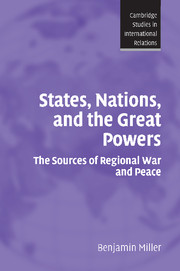Book contents
- Frontmatter
- Contents
- List of figures
- List of tables
- Preface and acknowledgments
- 1 Why some regions are peaceful and others are not
- 2 A theory of regional war and peace
- 3 States, nations, and war
- 4 Explaining the war proneness of the Middle East
- 5 The great powers war and peace in the Middle East
- 6 War and peace in the Balkans: states, nations, and great powers
- 7 The state-to-nation balance and the emergence of peace in South America during the twentieth century
- 8 The emergence of high-level peace in post-1945 Western Europe: nationalism, democracy, hegemony, and regional integration
- 9 Conclusions
- Appendix A Comparative dimensions of the state-to-nation imbalance in the Middle East, the Balkans, South America, and Western Europe in the post-1945 era
- Appendix B Data-file: major armed conflicts/wars by region, type, and modes of great power regional involvement (1945–2004)
- Bibliography
- Index
- Cambridge Studies in International Relations
4 - Explaining the war proneness of the Middle East
Published online by Cambridge University Press: 22 September 2009
- Frontmatter
- Contents
- List of figures
- List of tables
- Preface and acknowledgments
- 1 Why some regions are peaceful and others are not
- 2 A theory of regional war and peace
- 3 States, nations, and war
- 4 Explaining the war proneness of the Middle East
- 5 The great powers war and peace in the Middle East
- 6 War and peace in the Balkans: states, nations, and great powers
- 7 The state-to-nation balance and the emergence of peace in South America during the twentieth century
- 8 The emergence of high-level peace in post-1945 Western Europe: nationalism, democracy, hegemony, and regional integration
- 9 Conclusions
- Appendix A Comparative dimensions of the state-to-nation imbalance in the Middle East, the Balkans, South America, and Western Europe in the post-1945 era
- Appendix B Data-file: major armed conflicts/wars by region, type, and modes of great power regional involvement (1945–2004)
- Bibliography
- Index
- Cambridge Studies in International Relations
Summary
The collapse of the Arab–Israeli peace process and eruption of violence between Israelis and Palestinians in 2000–2004, and the recurrent Iraqi crises in the 1990s and the early 2000s, leading to the Iraq War in spring 2003, remind us that the Middle East has been one of the most war-prone regions in the post-World War II era in the sense of the intensity and recurrence of interstate warfare. Some of the major hot wars of the post-1945 era took place in the Middle East: six interstate Arab–Israeli wars in about fifty years, in addition to numerous other crossborder violent incidents between Arabs and Israelis; the eight-year Iran–Iraq war in the 1980s; the Iraqi invasion of Kuwait in 1990, which escalated to a major international crisis; and a number of supposedly civil wars internationalized by the involvement of regional states. The war proneness of the region influences states' conduct during peacetime as well. The danger of war looms large in the region almost constantly and the actors behave accordingly and prepare themselves for that possibility, mainly by arming themselves and building alliances. Thus, the Middle East surpasses other Third World regions in defense spending and in the deployment and import of various categories of weapons systems. Indeed, the Middle East is the most highly militarized region of the globe. The Middle East has also been notable for numerous competitive alliances among regional actors and between them and the superpowers (Walt 1987).
- Type
- Chapter
- Information
- States, Nations, and the Great PowersThe Sources of Regional War and Peace, pp. 129 - 204Publisher: Cambridge University PressPrint publication year: 2007

